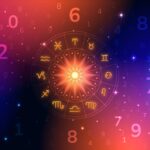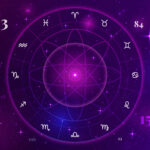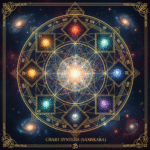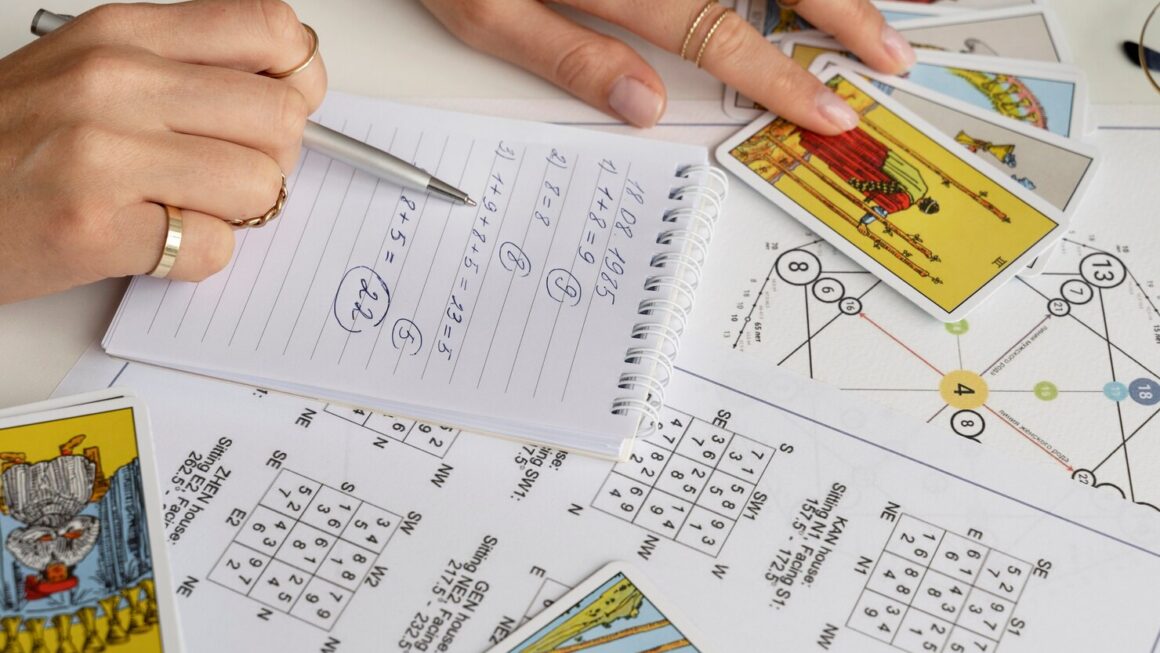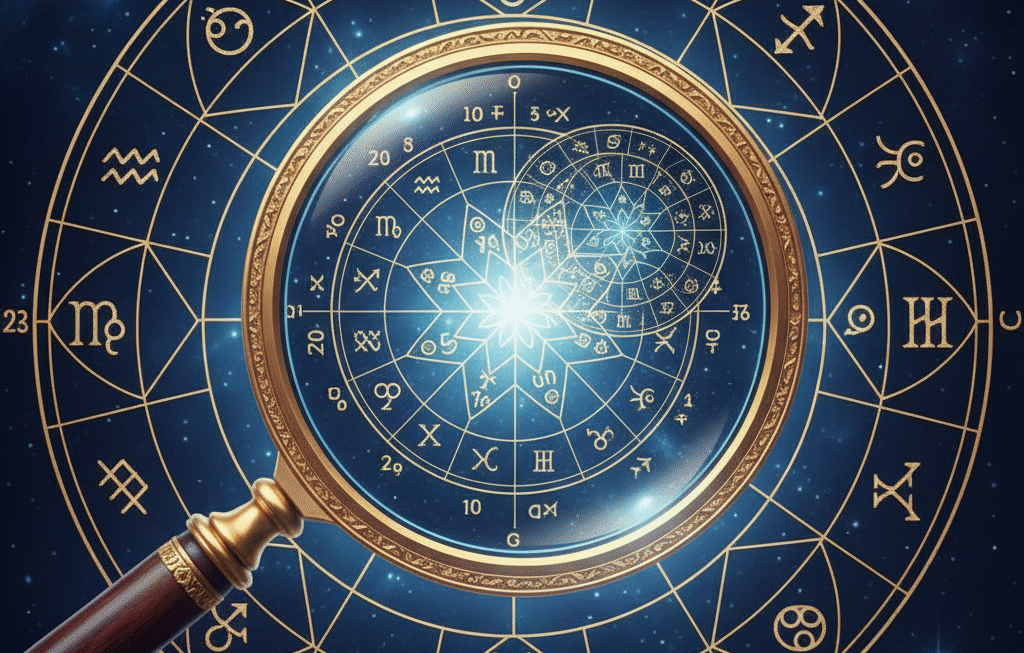Table of Contents
Why does one person with a powerful-looking birth chart struggle, while another with a seemingly average chart achieves great success and inner peace? What is the secret that separates a superficially “good” horoscope from one that delivers genuine, lasting results? In the intricate, layered system of Vedic astrology (Jyotish), the answer most often lies beyond the main birth chart (D1/Rasi). It is found in the most important of all divisional charts: the Navamsa chart D9.
Understanding the Navamsa is the key to unlocking the true quality and karmic promise of your entire horoscope. It is the astrological “code-breaker’s” most trusted tool. This article delves into the profound significance of the navamsa chart d9, explaining its critical role in assessing both navamsa marriage potential and your deeper life purpose, or Dharma.

Astrological Yogas: The Rasi Chart’s Promise vs. Reality
In Jyotish, planetary yogas or combinations in astrology (like Raja Yogas for power or Dhana Yogas for wealth) are formed in the Rasi chart (D1). This main chart is the foundational map of your life, showing the physical, tangible world, your body, your environment, and the broad potential of events. It’s the “promise” of your karma.
However, a promise is not the same as the final delivery. The Rasi chart, by itself, is a blunt instrument. A single house, like the 5th house, governs many different things: intellect, children, creativity, investments, and past life merit. A strong 5th lord in the Rasi chart is a general positive sign, but it doesn’t tell you the specific quality of each of these areas. Will your intellect be brilliant but your investments fail? Will you have wonderful children but no creative success? The Rasi chart struggles to differentiate. This is where the profound varga significance comes into play.
Why the Navamsa is Non-Negotiable in Astrological Analysis
(Opinion): The Navamsa chart D9 is, without question, the most important divisional chart in all of Vedic astrology. Relying solely on the Rasi (D1) chart for specific, nuanced predictions is a fundamental flaw that leads to the majority of failed interpretations. The true significance of the D9 lies in its power to reveal the intrinsic quality, true operational strength, and karmic fruit of every planet and every promise in the main birth chart.
(Reason): The Rasi chart is the “tree”—it shows the physical, visible structure of your life. The Navamsa chart is the “fruit”—it reveals the quality of the results you will actually get. The D9 is a harmonic chart created by dividing each 30-degree sign into nine equal segments (‘amsas’) of 3°20′ each.
A planet’s position in one of these tiny segments in the Rasi chart determines its new sign in the Navamsa chart. This mathematical “zooming in” acts as a filter, revealing the planet’s deeper, underlying strength and karmic essence. The D1 chart shows the promise, while the D9 chart shows the actual quality of that promise.
(Example): This is the ultimate “mythbuster” for why yogas fail. Let’s say a person has Venus (planet of love, luxury, and art) exalted in Pisces in their 10th house of career in the Rasi chart. A superficial analysis would predict guaranteed, high-status success as an artist, designer, or media personality (a Malavya Yoga). However, you must check the D9. If that same Venus, despite being exalted in the D1, falls into the sign of Virgo (its debilitation sign) in the navamsa chart d9, the story changes completely.
The Rasi promise shows the career path will be Venusian (e.g., in the arts), but the D9 weakness reveals the actual quality of the experience. This person might be a perpetually struggling artist, achieve fame that is plagued by scandals (a quality of debilitated Venus), or feel a profound lack of fulfillment despite outward success. The “promise” of the Rasi is undermined by the “reality” of the Navamsa.
Conversely, a planet debilitated in the Rasi chart (e.g., Sun in Libra) might look very weak, promising low confidence. But if that same Sun is exalted in Aries in the D9 chart, it shows immense inner strength, authority, and soul-power that will emerge, especially later in life, often leading to a powerful Neecha Bhanga Raja Yoga (cancellation of debilitation).
(Opinion/Restatement): Therefore, the navamsa chart d9 is the ultimate key to predictive accuracy. It reveals the why behind the what, showing the true, unshakeable quality of the planets and the yogas they form.
The Core Pillar: Navamsa Marriage Analysis
The D9 chart is most famous for its role in analyzing marriage. In fact, many traditional astrologers will not make any pronouncements on relationships without first examining it. The reason for this is twofold. First, the 7th house (of partnership) is refined in this chart.
Second, the Navamsa itself is the 9th harmonic chart, and the 9th house governs Dharma (righteous duty, purpose) and Bhagya (fortune). In Vedic tradition, marriage is considered a primary Dharma and a key part of one’s fortune, making the D9 the natural domain for its analysis. This is why navamsa marriage analysis is a cornerstone of Jyotish.
A Practical Method for D9 Interpretation in Marriage
(Pattern Spotter): When analyzing the potential for marital happiness, you must look at the D9 chart as a chart in its own right, with its own Ascendant. Here are the key “code-breaking” steps:
- The D9 Lagna (Ascendant): The sign rising in the D9 chart reveals the overall environment and quality of the marriage. Is it a fixed sign (stability), a movable sign (more changes), or a dual sign (a mix)? Is it ruled by a benefic (easier path) or a malefic (more challenges)?
- The D9 Lagna Lord: This planet’s placement within the D9 chart is crucial. Its strength and house placement show your own attitude, health, and role within the partnership. A strong D9 Lagna Lord (exalted or in its own sign) gives you the strength to navigate marital life successfully. If it falls into a challenging house in the D9 (like the 6th, 8th, or 12th), it can indicate conflict, hidden issues, or emotional distance, even if the D1 chart looks good.
- The D9 7th House and its Lord: This is the primary indicator of the spouse’s nature and the core dynamic of the relationship. Malefics like Saturn, Mars, or Rahu in the D9 7th house can indicate conflict, distance, or unconventionality in the partner, while benefics like Jupiter or Venus promise harmony and a good-natured spouse.
- Venus and Jupiter in the D9: These are the Karakas or natural significators. Venus represents love, harmony, and affection. Jupiter represents wisdom, grace, and in a female chart, the husband. The strength of these two planets in the D9 chart is paramount. You can have a “perfect” D1 chart for marriage, but if Venus is debilitated or heavily afflicted in the D9, that essential spark of love, harmony, and mutual respect may be lacking.
- Afflictions: Pay close attention to how malefics (Saturn, Mars, Rahu, Ketu) impact the D9 Lagna, 7th house, and the Karakas. These highlight the specific karmic challenges the relationship will face.
D9 Interpretation: The Chart of Dharma and Inner Strength
While its role in navamsa marriage analysis is famous, the d9 chart vedic astrology significance goes much deeper. The D9 is, at its core, the chart of your Dharma—your higher purpose and righteous path. It reveals the true, intrinsic quality of every planet.
This is why the D9 is used to judge the real strength of all Yogas, including Raja Yogas (power) and Dhana Yogas (wealth). A Raja Yoga in the D1 formed by planets that are debilitated or weak in the D9 will give status and power, but it will be hollow, short-lived, or corrupt. A Raja Yoga formed by planets that are also strong in the D9 (exalted, Vargottama) bestows power that is stable, righteous, and truly deserved.
Key Concept: Vargottama
(Pattern Spotter): This is a key term in navamsa analysis. When a planet occupies the same sign in both the Rasi (D1) chart and the Navamsa (D9) chart, it is called Vargottama. This is a position of immense strength. A Vargottama planet, even if it is in a “neutral” or “enemy” sign in the D1, becomes exceptionally powerful and will deliver its results with great consistency and force throughout the person’s life. A debilitated planet that is also Vargottama (e.g., Sun in Libra in both D1 and D9) often forms a powerful Neecha Bhanga Raja Yoga, indicating a rise from adversity.
Mythbusting: Common Misconceptions About the Navamsa
(Engagement): Because the navamsa chart d9 is so powerful, it is also surrounded by myths. Let’s bust a few.
Myth 1: “The D9 chart only ‘activates’ after marriage or after age 30.”
Busted: This is one of the most common and damaging misconceptions. Your D9 chart is active from the moment you are born. It represents your inherent, karmic quality—the “soul” of your planets. It is the subtle body that exists alongside your physical body (D1). While its themes (marriage, dharma) become more prominent in adulthood, a planet’s D9 strength or weakness influences its behavior and results in all stages of life.
Myth 2: “A ‘bad’ Rasi (D1) chart can be ‘fixed’ by a ‘good’ D9.”
Partially Busted: This requires nuance. The D1 chart shows the tangible, physical reality. The D9 shows the inner quality. If the D1 is very weak (indicating, for example, poverty or low status) but the D9 is incredibly strong, it may not mean the person will become a king. It more likely indicates a person of immense inner strength, wisdom, and contentment who lives a simple physical life. It shows an “inner king” regardless of outer circumstances. Sometimes, it can indicate a dramatic rise in status, but only after the initial struggles promised by the D1 have been overcome, often late in life.
Myth 3: “A 5-minute birth time error doesn’t matter for the D9.”
Busted: This is the most dangerous myth of all. The Ascendant (Lagna) of the Rasi chart changes signs roughly every two hours. The Ascendant of the Navamsa chart (D9 Lagna) changes signs, on average, every 13-14 minutes. A birth time error of just 5-10 minutes can completely change the D9 Lagna, which in turn shifts all the house placements in the D9, rendering any specific analysis of marriage or dharma completely incorrect. Accurate, rectified birth time is essential for any serious navamsa analysis.
Conclusion: The Key to Your Karmic Quality
The navamsa chart d9 is the most indispensable tool for moving beyond a superficial “cookbook” reading of a horoscope. It is the key to understanding the why behind the what. It reveals the true, intrinsic quality of your planets, the hidden strengths and weaknesses of your character, and the ultimate “fruit” of the promises seen in your main birth chart.
Whether you are seeking to understand the potential for your navamsa marriage, the true strength of your career yogas, or the nature of your life’s deeper purpose (Dharma), the answers are almost always found in the subtle and profound landscape of the D9. It is the map of your soul, and learning to read it is the first step toward true astrological wisdom.


